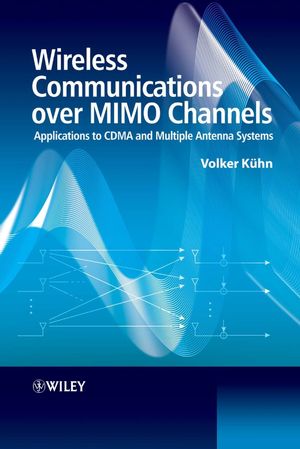Wireless Communications over MIMO Channels: Applications to CDMA and Multiple Antenna SystemsISBN: 978-0-470-02716-5
Hardcover
388 pages
August 2006
 |
||||||
Preface xi
Acknowledgements xv
List of Abbreviations xvii
List of Symbols xxi
1 Introduction to Digital Communications 1
1.1 Basic SystemModel 1
1.1.1 Introduction 1
1.1.2 Multiple Access Techniques 3
1.1.3 Principle Structure of SISO Systems 5
1.2 Characteristics ofMobile Radio Channels 8
1.2.1 Equivalent Baseband Representation 8
1.2.2 Additive White Gaussian Noise 11
1.2.3 Frequency-Selective Time-Variant Fading 12
1.2.4 Systems with Multiple Inputs and Outputs 16
1.3 Signal Detection 18
1.3.1 Optimal Decision Criteria 18
1.3.2 Error Probability for AWGN Channel 20
1.3.3 Error and Outage Probability for Flat Fading Channels 22
1.3.4 Time-Discrete Matched Filter 25
1.4 Digital Linear Modulation 27
1.4.1 Introduction 27
1.4.2 Amplitude Shift Keying (ASK) 28
1.4.3 Quadrature Amplitude Modulation (QAM) 30
1.4.4 Phase Shift Keying (PSK) 33
1.5 Diversity 36
1.5.1 General Concept 36
1.5.2 MRC for Independent Diversity Branches 40
1.5.3 MRC for Correlated Diversity Branches 47
1.6 Summary 49
2 Information Theory 51
2.1 Basic Definitions 51
2.1.1 Information, Redundancy, and Entropy 51
2.1.2 Conditional, Joint and Mutual Information 53
2.1.3 Extension for Continuous Signals 56
2.1.4 Extension for Vectors and Matrices 57
2.2 Channel Coding Theorem for SISO Channels 58
2.2.1 Channel Capacity 58
2.2.2 Cutoff Rate 59
2.2.3 Gallager Exponent 62
2.2.4 Capacity of the AWGN Channel 64
2.2.5 Capacity of Fading Channel 68
2.2.6 Channel Capacity and Diversity 70
2.3 Channel Capacity ofMIMO Systems 73
2.4 Channel Capacity for Multiuser Communications 78
2.4.1 Single Antenna AWGN Channel 78
2.4.2 Single Antenna Flat Fading Channel 82
2.4.3 Multiple Antennas at Transmitter and Receiver 85
2.5 Summary 89
3 Forward Error Correction Coding 91
3.1 Introduction 92
3.2 Linear Block Codes 94
3.2.1 Description byMatrices 94
3.2.2 Simple Parity Check and Repetition Codes 97
3.2.3 Hamming and Simplex Codes 98
3.2.4 Hadamard Codes 99
3.2.5 Trellis Representation of Linear Block Codes 99
3.3 Convolutional Codes 100
3.3.1 Structure of Encoder 101
3.3.2 Graphical Description of Convolutional Codes 104
3.3.3 Puncturing Convolutional Codes 105
3.3.4 ML Decoding with Viterbi Algorithm 106
3.4 Soft-Output Decoding of Binary Codes 109
3.4.1 Log-Likelihood Ratios – A Measure of Reliability 109
3.4.2 General Approach for Soft-Output Decoding 112
3.4.3 Soft-Output Decoding for Walsh Codes 114
3.4.4 BCJR Algorithm for Binary Block Codes 115
3.4.5 BCJR Algorithm for Binary Convolutional Codes 118
3.4.6 Implementation in Logarithmic Domain 120
3.5 Performance Evaluation of Linear Codes 121
3.5.1 Distance Properties of Codes 121
3.5.2 Error Rate Performance of Codes 125
3.5.3 Information Processing Characteristic 131
3.6 Concatenated Codes 135
3.6.1 Introduction 135
3.6.2 Performance Analysis for Serial Concatenation 137
3.6.3 Performance Analysis for Parallel Concatenation 141
3.6.4 Turbo Decoding of Concatenated Codes 146
3.6.5 EXIT Charts Analysis of Turbo Decoding 153
3.7 Low-Density Parity Check (LDPC) Codes 160
3.7.1 Basic Definitions and Encoding 160
3.7.2 Graphical Description 165
3.7.3 Decoding of LDPC Codes 167
3.7.4 Performance of LDPC Codes 169
3.8 Summary 171
4 Code Division Multiple Access 173
4.1 Fundamentals 174
4.1.1 Direct-Sequence Spread Spectrum 174
4.1.2 Direct-Sequence CDMA 181
4.1.3 Single-User Matched Filter (SUMF) 185
4.1.4 Spreading Codes 191
4.2 OFDM-CDMA 194
4.2.1 Multicarrier Transmission 194
4.2.2 Orthogonal Frequency Division Multiplexing 195
4.2.3 Combining OFDMand CDMA 200
4.3 Low-Rate Channel Coding in CDMA Systems 208
4.3.1 Conventional Coding Scheme (CCS) 209
4.3.2 Code-Spread Scheme (CSS) 210
4.3.3 Serially Concatenated Coding Scheme (SCCS) 211
4.3.4 Parallel Concatenated Coding Scheme (PCCS) 214
4.3.5 Influence of MUI on Coding Schemes 216
4.4 Uplink Capacity of CDMA Systems 219
4.4.1 Orthogonal Spreading Codes 220
4.4.2 Random Spreading Codes and Optimum Receiver 220
4.4.3 Random Spreading Codes and Linear Receivers 222
4.5 Summary 225
5 Multiuser Detection in CDMA Systems 227
5.1 Optimum Detection 227
5.1.1 Optimum Joint Sequence Detection 228
5.1.2 Joint Preprocessing and Subsequent Separate Decoding 229
5.1.3 Turbo Detection with Joint Preprocessing and Separate Decoding 231
5.2 Linear Multiuser Detection 233
5.2.1 Decorrelator (Zero-Forcing, ZF) 233
5.2.2 Minimum Mean Squared Error Receiver (MMSE) 236
5.2.3 Linear Parallel Interference Cancellation (PIC) 240
5.2.4 Linear Successive Interference Cancellation (SIC) 243
5.3 Nonlinear Iterative Multiuser Detection 245
5.3.1 Nonlinear Devices 245
5.3.2 Uncoded Nonlinear Interference Cancellation 247
5.3.3 Nonlinear Coded Interference Cancellation 253
5.4 Combining Linear MUD and Nonlinear SIC 258
5.4.1 BLAST-like Detection 258
5.4.2 QL Decomposition for Zero-Forcing Solution 258
5.4.3 QL Decomposition for MMSE Solution 268
5.4.4 Turbo Processing 270
5.5 Summary 273
6 Multiple Antenna Systems 275
6.1 Introduction 275
6.2 Spatial Diversity Concepts 277
6.2.1 Receive Diversity 277
6.2.2 Performance Analysis of Space–Time Codes 279
6.2.3 Orthogonal Space–Time Block Codes 282
6.2.4 Space–Time Trellis Codes 293
6.3 Multilayer Transmission 304
6.3.1 Channel Knowledge at the Transmitter and Receiver 304
6.3.2 Channel Knowledge only at the Receiver 306
6.3.3 Performance of Multilayer Detection Schemes 308
6.3.4 Lattice Reduction-Aided Detection 312
6.4 Linear Dispersion Codes 319
6.4.1 LD Description of Alamouti’s Scheme 320
6.4.2 LD Description of Multilayer Transmissions 321
6.4.3 LD Description of Beamforming 321
6.4.4 Optimizing Linear Dispersion Codes 322
6.4.5 Detection of Linear Dispersion Codes 323
6.5 Information Theoretic Analysis 323
6.5.1 UncorrelatedMIMO Channels 323
6.5.2 CorrelatedMIMO Channels 325
6.6 Summary 328
Appendix A Channel Models 329
A.1 Equivalent Baseband Representation 329
A.2 Typical Propagation Profiles for Outdoor Mobile Radio Channels 330
A.3 Moment-Generating Function for Ricean Fading 331
Appendix B Derivations for Information Theory 333
B.1 Chain Rule for Entropies 333
B.2 Chain Rule for Information 333
B.3 Data-Processing Theorem 334
Appendix C Linear Algebra 335
C.1 Selected Basics 335
C.2 Householder Reflections and Givens Rotation 341
C.3 LLL Lattice Reduction 343
Bibliography 347
Index 359



